Marine Heatwaves in the Indonesian Fisheries Management Areas
Abstract
1. Introduction
2. Materials and Methods
2.1. Data
2.2. MHWs Detection and Their Metrics
3. Results
3.1. Mean and Trend of MHW Metrics
3.2. Categorization of MHWs in Indonesian FMAs
4. Discussion
5. Conclusions
Author Contributions
Funding
Institutional Review Board Statement
Informed Consent Statement
Data Availability Statement
Acknowledgments
Conflicts of Interest
References
- Collins, M.M.; Sutherland, M.; Bouwer, L.; Cheong, S.-M.; Frölicher, T.; Des Combes, H.J.; Roxy, M.K.; Losada, I.; McInnes, K.; Ratter, B.; et al. Extremes, Abrupt Changes and Managing Risks. In IPCC Special Report on the Ocean and Cryosphere in a Changing Climate; Pörtner, H.-O., Roberts, D.C., Masson-Delmotte, V., Zhai, M.T.P., Poloczanska, E., Mintenbeck, K., Alegría, A., Nicolai, M., Okem, A., Petzold, J., et al., Eds.; IPCC: Geneva, Switzerland, 2019; Available online: https://www.ipcc.ch/site/assets/uploads/sites/3/2019/11/10_SROCC_Ch06_FINAL.pdf (accessed on 15 October 2021).
- Hobday, A.J.; Alexander, L.V.; Perkins, S.E.; Smale, D.A.; Straub, S.C.; Oliver, E.C.J.; Benthuysen, J.A.; Burrows, M.T.; Donat, M.G.; Feng, M.; et al. A hierarchical approach to defining marine heatwaves. Prog. Oceanogr. 2016, 141, 227–238. [Google Scholar] [CrossRef]
- Hobday, A.J.; Oliver, E.C.J.; Gupta, A.S.; Benthuysen, J.A.; Burrows, M.T.; Donat, M.G.; Holbrook, N.J.; Moore, P.J.; Thomsen, M.S.; Wernberg, T.; et al. Categorizing and Naming Marine Heatwaves. Oceanography 2018, 31, 162–173. [Google Scholar] [CrossRef]
- Mills, K.E.; Pershing, A.J.; Brown, C.J.; Chen, Y.; Chiang, F.-S.; Holland, D.S.; Lehuta, S.; Nye, J.A.; Sun, J.C.; Thomas, A.C.; et al. Fisheries Management in a Changing Climate: Lessons from the 2012 Ocean Heat Wave in the Northwest Atlantic. Oceanography 2013, 26, 191–195. [Google Scholar] [CrossRef]
- Pearce, A.F.; Feng, M. The rise and fall of the “marine heat wave” off Western Australia during the summer of 2010/2011. J. Mar. Syst. 2013, 111–112, 139–156. [Google Scholar] [CrossRef]
- Bond, N.A.; Cronin, M.F.; Freeland, H.; Mantua, N. Causes and impacts of the 2014 warm anomaly in the NE Pacific. Geophys. Res. Lett. 2015, 42, 3414–3420. [Google Scholar] [CrossRef]
- Chen, Z.; Shi, J.; Liu, Q.; Chen, H.; Li, C. A persistent and intense marine heatwave in the Northeast Pacific during 2019–2020. Geophys. Res. Lett. 2021, 48, e2021GL093239. [Google Scholar] [CrossRef]
- Zhang, Y.; Du, Y.; Feng, M.; Hu, S. Long-lasting marine heatwaves instigated by ocean planetary waves in the tropical Indian Ocean during 2015–2016 and 2019–2020. Geophys. Res. Lett. 2021, 48, e2021GL095350. [Google Scholar] [CrossRef]
- Chen, K.; Gawarkiewicz, G.G.; Lentz, S.J.; Bane, J.M. Diagnosing the warming of the northeastern U.S. coastal ocean in 2012: A linkage between the atmospheric jet stream variability and ocean response. J. Geophys. Res. Ocean. 2014, 119, 218–227. [Google Scholar] [CrossRef]
- Hu, S.; Li, S.; Zhang, Y.; Guan, C.; Du, Y.; Feng, M.; Ando, K.; Wang, F.; Schiller, A.; Hu, D. Observed strong subsurface marine heatwaves in the tropical western Pacific Ocean. Environ. Res. Lett. 2021, 16, 104024. [Google Scholar] [CrossRef]
- Oliver, E.C.J.; Donat, M.G.; Burrows, M.T.; Moore, P.J.; Smale, D.A.; Alexander, L.V.; Benthuysen, J.A.; Feng, M.; Gupta, A.S.; Hobday, A.J.; et al. Longer and more frequent marine heatwaves over the past century. Nat. Commun. 2018, 9, 1324. [Google Scholar] [CrossRef]
- Sprintall, J.; Cravatte, S.; Dewitte, B.; Du, Y.; Gupta, A.S. ENSO Oceanic Teleconnections. In El Niño Southern Oscillation in a Changing Climate; McPhaden, M., Santoso, A., Cai, W., Eds.; Wiley: Hoboken, NJ, USA, 2020. [Google Scholar] [CrossRef]
- Frölicher, T.L.; Fischer, E.M.; Gruber, N. Marine heatwaves under global warming. Nature 2018, 560, 360–364. [Google Scholar] [CrossRef] [PubMed]
- Iskandar, M.R.; Ismail, M.F.A.; Arifin, T.; Chandra, H. Marine heatwaves of sea surface temperature off south Java. Heliyon 2021, 7, e08618. [Google Scholar] [CrossRef] [PubMed]
- Ismail, M.F.A. Characteristics of Marine Heatwaves off West Sumatra Derived from High-Resolution Satellite Data. J. Hunan Univ. Nat. Sci. 2021, 48, 130–136. [Google Scholar]
- Veron, J.C.E.; DeVantier, L.M.; Turak, E.; Green, A.L.; Kininmonth, S.; Stafford-Smith, M.; Peterson, N. The Coral Triangle. In Coral Reefs: An Ecosystem in Transition; Dubinsky, Z., Stambler, N., Eds.; Springer: Dordrecht, The Netherlands, 2011. [Google Scholar] [CrossRef]
- Hughes, T.P.; Kerry, J.T.; Álvarez-Noriega, M.; Álvarez-Romero, J.G.; Anderson, K.D.; Baird, A.H.; Babcock, R.C.; Beger, M.; Bellwood, D.R.; Berkelmans, R.; et al. Global warming and recurrent mass bleaching of corals. Nature 2017, 543, 373–377. [Google Scholar] [CrossRef]
- Hughes, T.P.; Anderson, K.D.; Connolly, S.R.; Heron, S.F.; Kerry, J.T.; Lough, J.M.; Baird, A.H.; Baum, J.K.; Berumen, M.L.; Bridge, T.C.; et al. Spatial and temporal patterns of mass bleaching of corals in the Anthropocene. Science 2018, 359, 80–83. [Google Scholar] [CrossRef]
- World Bank. Capture Fisheries Production (Metric Tons)—Indonesia. 2020. Available online: https://data.worldbank.org/indicator/ER.FSH.CAPT.MT?end=2020&locations=ID&start=2010 (accessed on 16 November 2022).
- Huang, B.; Liu, C.; Banzon, V.; Freeman, E.; Graham, G.; Hankins, B.; Smith, T.; Zhang, H.-M. Improvements of the Daily Optimum Interpolation Sea Surface Temperature (DOISST) Version 2.1. J. Clim. 2021, 34, 2923–2939. [Google Scholar] [CrossRef]
- Reynolds, R.W.; Smith, T.M.; Liu, C.; Chelton, D.B.; Casey, K.S.; Schlax, M.G. Daily High-Resolution-Blended Analyses for Sea Surface Temperature. J. Clim. 2007, 20, 5473–5496. [Google Scholar] [CrossRef]
- Pusat Riset Kelautan. Indonesia Fishing Management Area. 2013. Available online: http://pusriskel.litbang.kkp.go.id/index.php/en/data/perairan-indonesia/category/70-shape-file-laut-indonesia?download=590%3Awpp-juni-2011 (accessed on 26 May 2022).
- Habibullah, A.D.; Tarya, A. Sea surface temperature variability in Indonesia and its relation to regional climate indices. IOP Conf. Ser. Earth Environ. Sci. 2021, 925, 012008. [Google Scholar] [CrossRef]
- Tan, H.-J.; Cai, R.-S.; Wu, R.-G. Summer marine heatwaves in the South China Sea: Trend, variability and possible causes. Adv. Clim. Chang. Res. 2020, 13, 323–332. [Google Scholar] [CrossRef]
- Liu, Q.-Y.; Feng, M.; Wang, D.; Wijffels, S. Interannual variability of the Indonesian Throughflow transport: A revisit based on 30 year expendable bathythermograph data. J. Geophys. Res. Oceans 2015, 120, 8270–8282. [Google Scholar] [CrossRef]
- England, M.H.; Huang, F. On the Interannual Variability of the Indonesian Throughflow and Its Linkage with ENSO. J. Clim. 2005, 18, 1435–1444. [Google Scholar] [CrossRef]
- Li, M.; Gordon, A.L.; Gruenburg, L.K.; Wei, J.; Yang, S. Interannual to Decadal Response of the Indonesian Throughflow Vertical Profile to Indo-Pacific Forcing. Geophys. Res. Lett. 2020, 47, e2020GL087679. [Google Scholar] [CrossRef]
- Saji, N.H.; Goswami, B.N.; Vinayachandran, P.N.; Yamagata, T. A dipole mode in the tropical Indian Ocean. Nature 1999, 401, 360–363. [Google Scholar] [CrossRef]
- Mohamed, B.; Nagy, H.; Ibrahim, O. Spatiotemporal Variability and Trends of Marine Heat Waves in the Red Sea over 38 Years. J. Mar. Sci. Eng. 2021, 9, 842. [Google Scholar] [CrossRef]
- Smale, D.A.; Wernberg, T.; Oliver, E.C.J.; Thomsen, M.; Harvey, B.P.; Straub, S.C.; Burrows, M.T.; Alexander, L.V.; Benthuysen, J.A.; Donat, M.G.; et al. Marine heatwaves threaten global biodiversity and the provision of ecosystem services. Nat. Clim. Chang. 2019, 9, 306–312. [Google Scholar] [CrossRef]
- H Garrabou, J.; Gómez-Gras, D.; Medrano, A.; Cerrano, C.; Ponti, M.; Schlegel, R.; Bensoussan, N.; Turicchia, E.; Sini, M.; Gerovasileiou, V.; et al. Marine heatwaves drive recurrent mass mortalities in the Mediterranean Sea. Glob. Chang. Biol. 2022, 28, 5708–5725. [Google Scholar] [CrossRef] [PubMed]
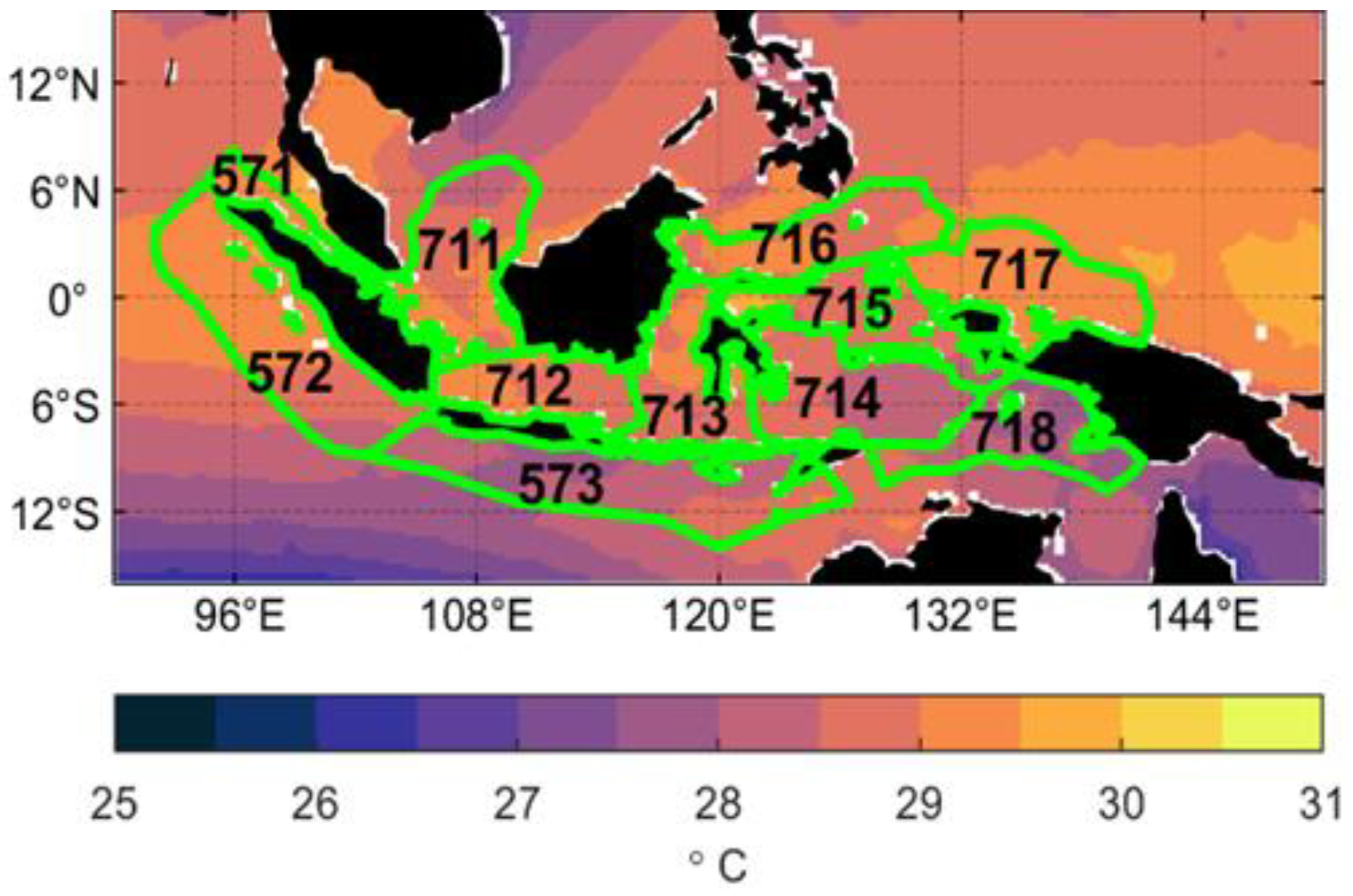
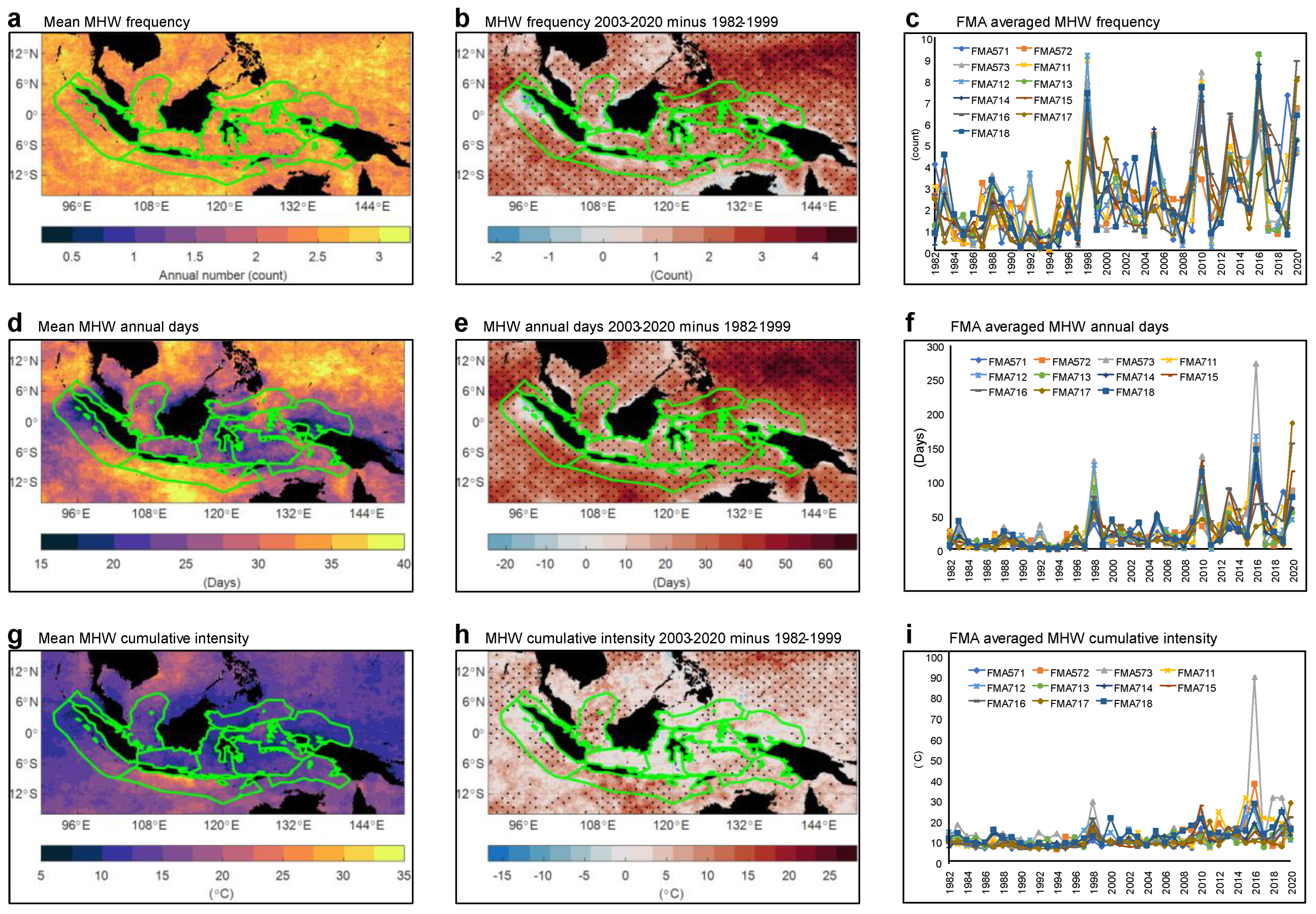
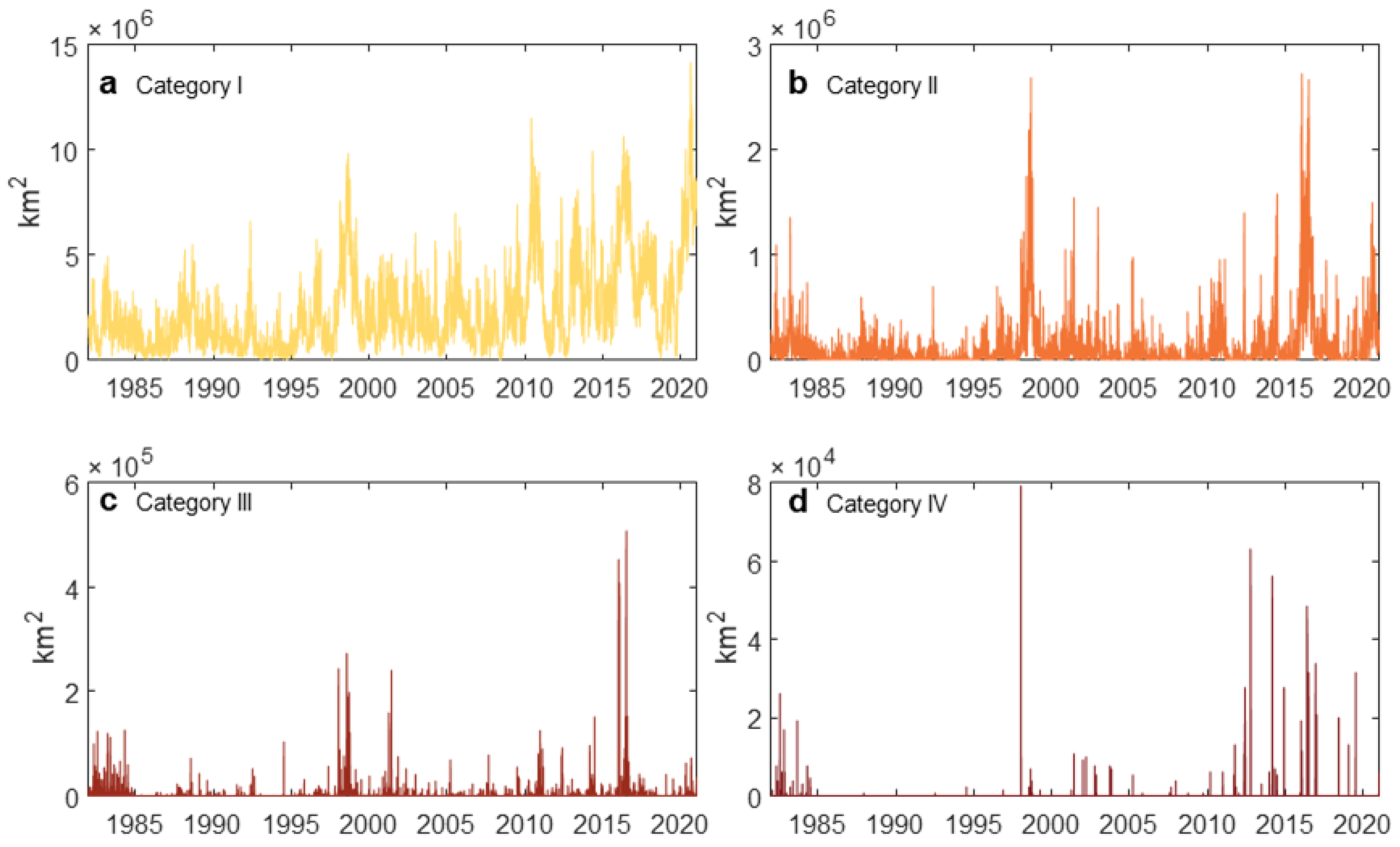
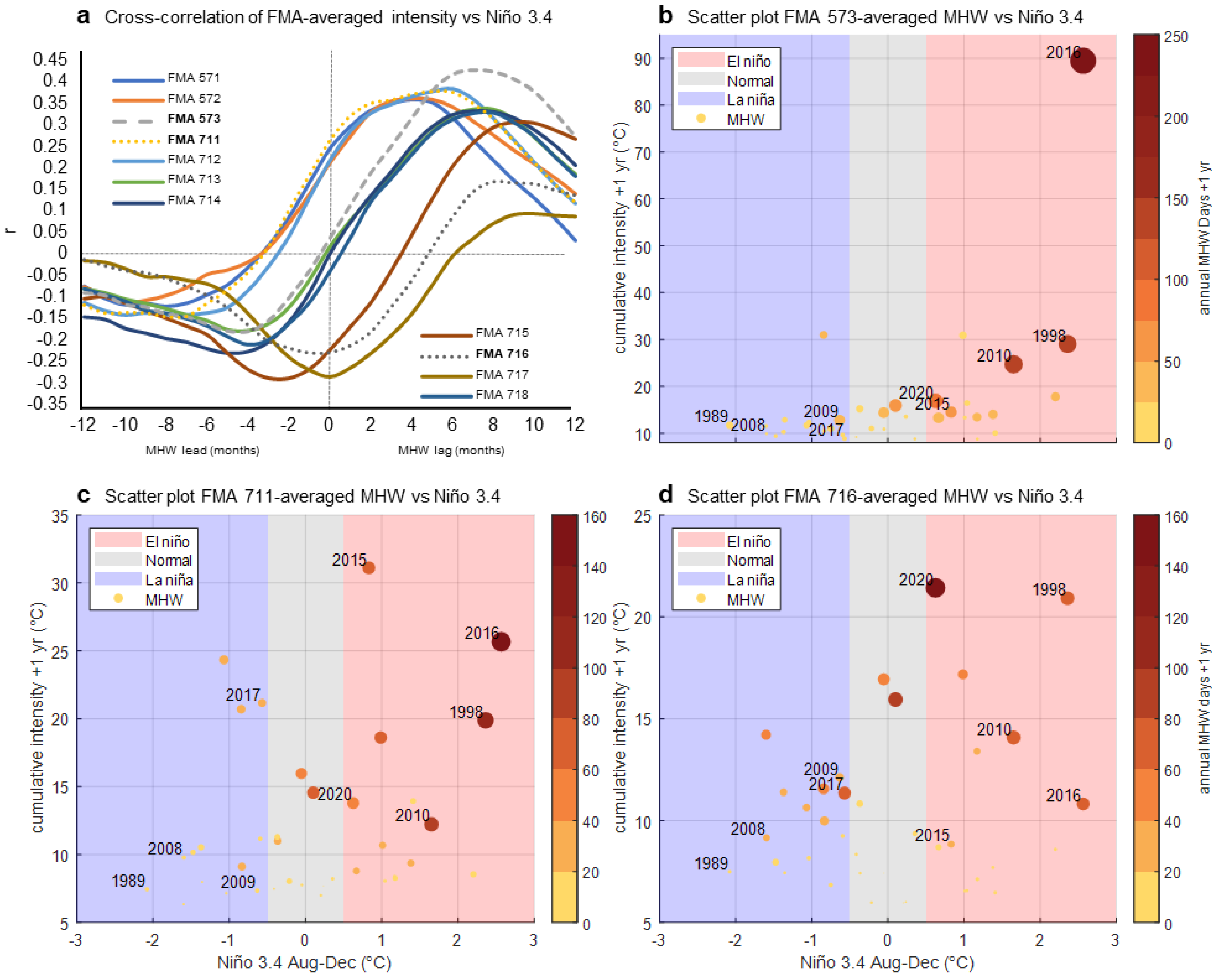

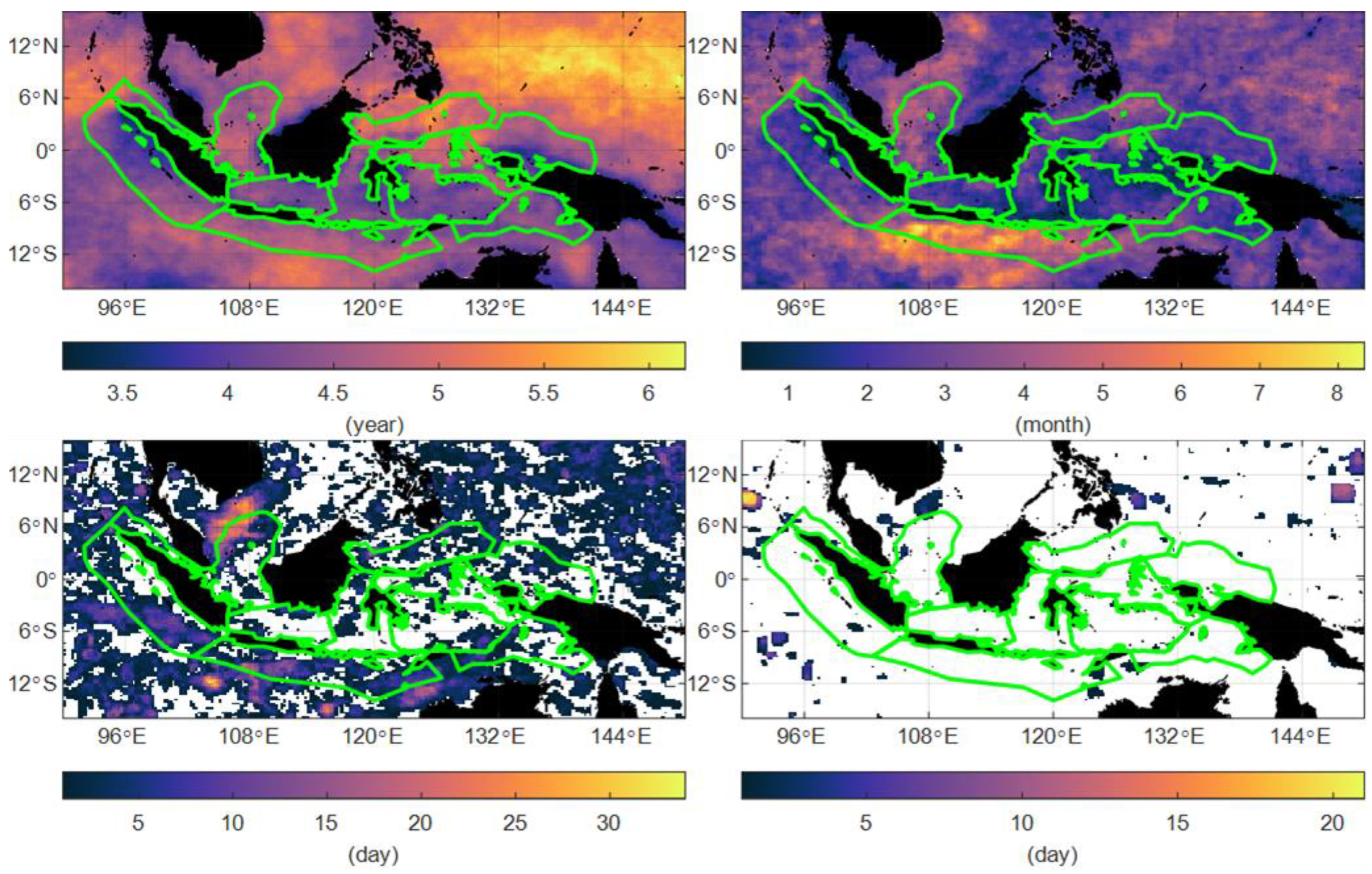
| FMA | Cumulative Intensity | MHW Days | Annual Frequency | |||
|---|---|---|---|---|---|---|
| Mean | Trend (°C/Decade) | Mean | Trend (Days/Decade) | Mean | Trend (Events/Decade) | |
| 571 | 11.13 | 2.16 | 23.63 | 13.00 | 2.38 | 0.74 |
| 572 | 13.46 | 2.10 | 25.76 | 11.14 | 2.46 | 0.51 |
| 573 | 19.74 | 4.27 | 33.27 | 16.63 | 2.46 | 0.71 |
| 711 | 14.02 | 3.58 | 27.51 | 14.50 | 2.44 | 0.72 |
| 712 | 12.53 | 1.12 | 25.39 | 9.48 | 2.49 | 0.58 |
| 713 | 11.57 | 0.75 | 23.47 | 8.99 | 2.38 | 0.67 |
| 714 | 12.14 | 1.65 | 23.23 | 10.29 | 2.31 | 0.69 |
| 715 | 12.08 | 1.49 | 26.01 | 13.61 | 2.46 | 0.93 |
| 716 | 12.21 | 1.81 | 27.56 | 17.38 | 2.52 | 1.22 |
| 717 | 11.12 | 1.17 | 23.05 | 11.06 | 2.32 | 0.68 |
| 718 | 14.72 | 2.20 | 26.85 | 10.80 | 2.47 | 0.61 |
Disclaimer/Publisher’s Note: The statements, opinions and data contained in all publications are solely those of the individual author(s) and contributor(s) and not of MDPI and/or the editor(s). MDPI and/or the editor(s) disclaim responsibility for any injury to people or property resulting from any ideas, methods, instructions or products referred to in the content. |
© 2023 by the authors. Licensee MDPI, Basel, Switzerland. This article is an open access article distributed under the terms and conditions of the Creative Commons Attribution (CC BY) license (https://creativecommons.org/licenses/by/4.0/).
Share and Cite
Habibullah, A.D.; Tarya, A.; Ningsih, N.S.; Putri, M.R. Marine Heatwaves in the Indonesian Fisheries Management Areas. J. Mar. Sci. Eng. 2023, 11, 161. https://doi.org/10.3390/jmse11010161
Habibullah AD, Tarya A, Ningsih NS, Putri MR. Marine Heatwaves in the Indonesian Fisheries Management Areas. Journal of Marine Science and Engineering. 2023; 11(1):161. https://doi.org/10.3390/jmse11010161
Chicago/Turabian StyleHabibullah, Ahmad Dhuha, Ayi Tarya, Nining Sari Ningsih, and Mutiara Rachmat Putri. 2023. "Marine Heatwaves in the Indonesian Fisheries Management Areas" Journal of Marine Science and Engineering 11, no. 1: 161. https://doi.org/10.3390/jmse11010161
APA StyleHabibullah, A. D., Tarya, A., Ningsih, N. S., & Putri, M. R. (2023). Marine Heatwaves in the Indonesian Fisheries Management Areas. Journal of Marine Science and Engineering, 11(1), 161. https://doi.org/10.3390/jmse11010161









